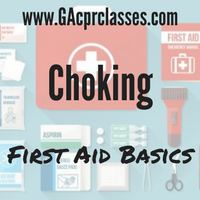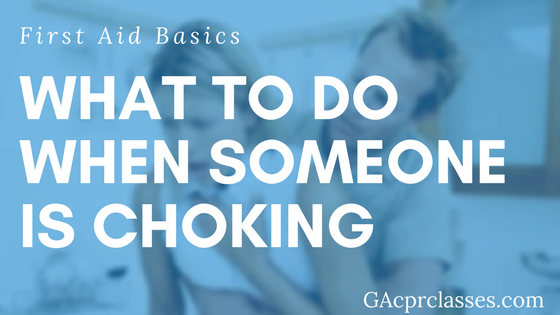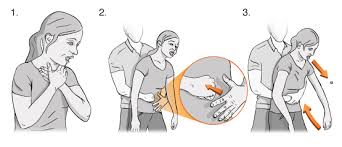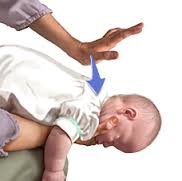First Aid Basics: What To Do When Someone Is Choking

[adinserter block=”2″]
[adinserter block=”3″]

Choking
Everyone has an idea of what choking is, what it looks like, and has more than likely witnessed someone choke at some point in their life. Choking is more technically known as Foreign-Body Airway Obstruction (FBAO) and most cases commonly occur while people are eating. Adults, children, and infants all are likely to have FBAO problems around food and eating, but children and infants can also have problems during play time. Many toys can easily become choking hazards, especially if swallowed by little ones.
Most choking cases are witnessed, giving a rescuer a chance to intervene before things get worse. Without oxygen, brain damage can occur in as little as 4 to 6 minutes. Recognition, acting quickly, and with treatment usually being successful, survival rates can exceed 95% for choking victims.

What To Do When Someone Is Choking
Most people do not understand that there are different types of choking. There is a mild end and a severe end, with each being dealt with differently. Recognition of choking and action are important in helping achieve a positive outcome. It is vital to differentiate between choking and other emergencies like fainting, heart attack, seizure, or other serious medical conditions.
Mild Choking
Mild choking occurs when a victim is having difficulty breathing, but CAN normally cough, talk, and generally move air out of the body. The victim has a chance to move the object on their own, so the rescuer will be on stand by and simply encourage the victim to cough and talk to help move the object themselves. Air is being thrust out of the body by the victim, hopefully moving the object lodged in the airway, and allowing them to possibly get some air in return.
First ask the victim if “Are you alright?” and “Are you choking?” If they indicate by speaking, coughing, and with universal signs of grabbing at the neck, start First Aid for choking by encouraging the victim to cough.
Keep encouraging the victim to cough the object out until:
- The object comes out and the person can breathe normal again
- The object becomes lodged further in the throat and closes the airway (becomes Severe Choking)
- The victim loses consciousness and passes out from lack of oxygen
Severe Choking
Severe choking occurs when the victim is having difficulty breathing, but CAN NOT talk, cough, or move air out of the body. Things can escalate quickly with severe choking and the odds of the person passing out go up by the second. The object is completely or mostly covering the airway and preventing any air from getting through.
If the victim responds to the questions are you alright and are you choking by only nodding their head without speaking, you will have to perform First Aid for severe choking by performing Abdominal Thrusts (formally the Heimlich Maneuver).
[adinserter block=”2″]
[adinserter block=”3″]
How To Perform Abdominal Thrusts
- Approach victim from behind
- Place hands under their arms and around towards the stomach. You will want to position one hand in a fist above the belly button, but below the rib cage. Place the other hand on top of the first.
- Pull in and up. This forces a coughing action on the victim, forcefully pushing air out of the stomach and diaphragm. The upward motions forces the air out of the body and hopefully moves the FBAO on its way out of the body. Repeat the thrusts as long as the person is severely choking.
 Abdominal Thrust Example | GAcprclasses.com
Abdominal Thrust Example | GAcprclasses.com
Stop performing Abdominal Thrusts when:
- The object comes out and the person can breathe normal again
- The object loosens, allowing the person to cough (becomes Mild Choking)
- The victim loses consciousness and passes out from lack of oxygen
How To Help A Choking Infant
Seeing that infants can not understand directions very well, the rescuer will have to perform more hands on First Aid for victims less than 1 year old that are choking.
- Turn infant onto your forearm, face down. Be sure to stabilize the head, neck, and spine while holding the infant.
- Start by delivering 5 back blows. You should be hitting them in a upward fashion, with the heel of your hand, and right between the shoulder blades.
- If the object does not come out from the back blows, rotate the infant onto the other forearm, face up. Still brace the head, neck, and spine so that you can have access to the chest. Use your index and middle fingers to perform 5 chest thrusts (like a compression, abdominal thrusts on infants can cause severe injuries).

Keep performing the 5 back slaps and 5 chest thrusts until:
- The object comes out and the infant can breathe normal again
- The victim goes unresponsive and passes out from lack of oxygen
If Anyone Passes Out From Choking
- Call 911 or send someone else to call. If someone else is going to call, ask them to bring back a first aid kit and AED. Even though you may not need them, it is always better to be prepared and have your tools than not to have them at all.
- Immediately begin CPR, starting with chest compressions. Push hard and fast in the center of the chest to help restore blood flow to the brain as quickly as possible.
- Before delivering breaths (with appropriate personal protective equipment), check the airway for the obstruction. Sometimes compressions can push the object up into the mouth where it can be removed. More often than not, you will not find anything and will have to proceed with your CPR and deliver the breaths like normal.
- If the first breath does not get the chest to rise, close the airway to its normal position and re open it to deliver the second breath. You should always deliver both breaths, even if they do not work or make the chest rise. Some air will always be better than no air, especially considering how long a choking victim can go without any at all.
Source: American Heart Association
Disclaimer: There are ads and affiliate links within our posts. We earn a small commission if you do choose to use the links and they do not add any additional cost to you if you do use them. Products are recommended because they are useful and helpful, not because of the commission possibly earned. Only use the links if you believe they can help you or you are interested in learning more about an advertisement.

Proudly offering American Heart Association workplace CPR training classes in the Greater Atlanta area. 3 local offices, online and classroom options, and cards are issued at the time you complete training. ACLS, CPR, BLS, First Aid, and PALS classes are available.
Jobs That Need BLS Training | Jobs That Need CPR Training
[adinserter block=”2″]
[adinserter block=”3″]